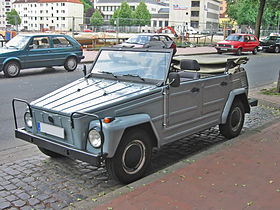This article needs additional citations for verification. (August 2019) |
| Volkswagen Type 181/182 | |
|---|---|
 | |
| Overview | |
| Manufacturer | Volkswagen |
| Also called | Volkswagen Type 181 (LHD) Volkswagen Type 182 (RHD) Sold as: Volkswagen Thing (United States) Volkswagen Camat (Indonesia) Volkswagen Safari (Mexico) Volkswagen Trekker (UK) Volkswagen Pescaccia (Italy) |
| Production | 1968–1983 (from 1971 for civilian use) 90,883 built (70,519 in West Germany, 20,364 in Mexico)[1] |
| Assembly | Wolfsburg, West Germany (1968–1974) Hannover, West Germany (1974–1975) Emden, West Germany (1975–1978) Puebla, Mexico (1970–1980) Jakarta, Indonesia (1972–1980) |
| Body and chassis | |
| Class | Military vehicle |
| Body style | 4-door cabriolet |
| Layout | Rear-engined, rear-wheel drive |
| Powertrain | |
| Engine | 1.5 or 1.6l H4 |
| Transmission | 4-speed manual |
| Dimensions | |
| Wheelbase | 2,400 mm (94.5 in) |
| Length | 3,780 mm (148.8 in) |
| Width | 1,640 mm (64.6 in) |
| Height | 1,620 mm (63.8 in) |
| Curb weight | 910 kg (2,006 lb) |
| Chronology | |
| Predecessor | Volkswagen Kübelwagen |
| Successor | Volkswagen Iltis (for military use) Volkswagen Touareg (for civilian use) |

The Volkswagen Type 181 is a two-wheel drive, four-door convertible, manufactured and marketed by Volkswagen from 1968 until 1983. Originally developed for the West German Army, the Type 181 also entered the civilian market as the Kurierwagen (“courier car”) in West Germany, the Trekker (RHD Type 182) in the United Kingdom, the Thing in the United States and Canada (1973–74), the Safari in Mexico and South America, and Pescaccia in Italy. Civilian sales ended after model year 1980.
Manufactured in Wolfsburg, West Germany (1968–1974), Hannover, West Germany (1974–1975), Emden, West Germany (1975–1978),[2] Puebla, Mexico (1970–1980), and Jakarta, Indonesia (1972–1980), the Type 181 shared its mechanicals with Volkswagen's Type 1 (Beetle) and the pre-1968 Volkswagen Microbus, its floor pan with the Type 1 Karmann Ghia, and its concept with the company's Kübelwagen, which had been used by the German military during World War II.
All four doors were removable and interchangeable, the windshield folded flat, and the convertible roof could be removed for al fresco driving. The spartan interior featured vinyl covered bucket seats, painted sheet metal, drain holes and perforated rubber mats. A fiberglass hardtop and trunk-mounted auxiliary heater were offered as individual options.
- ^ Oswald, Werner (2003). Deutsche Autos 1945–1990 [German autos, 1945–90] (in German). Vol. 3. Stuttgart: Motorbuch. p. 46. ISBN 3-613-02116-1.
- ^ "The VW Thing (Type 181) Registry" (PDF). July 2016.